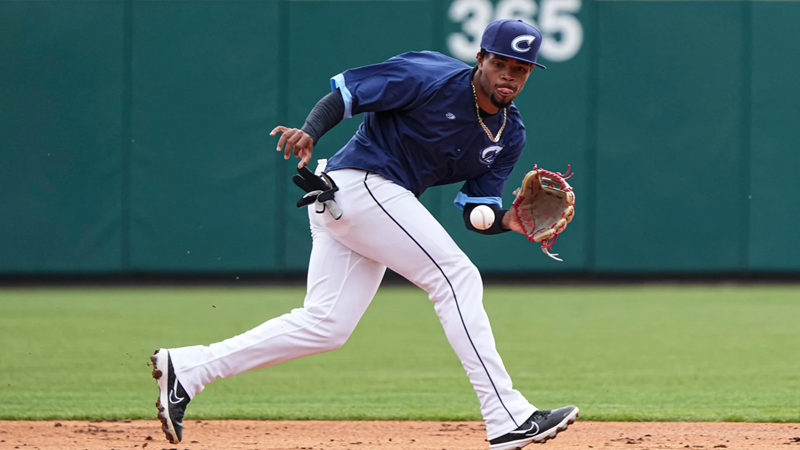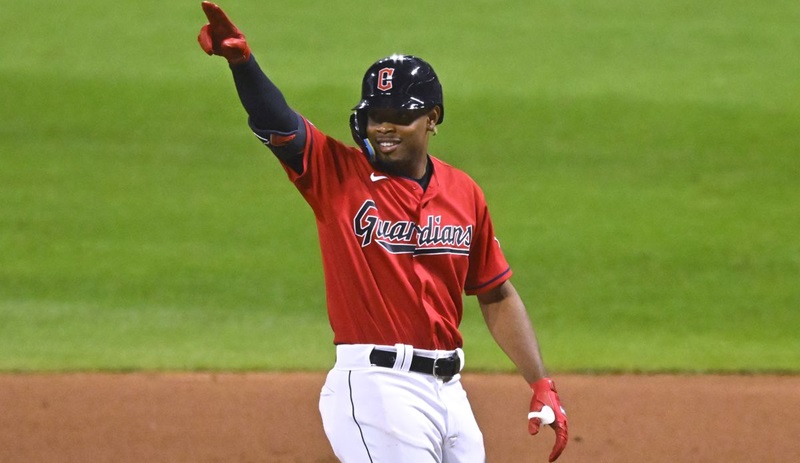Top prospect nearing return to the field: Guardians update
The Guardians, a high-profile baseball team, are eagerly awaiting the return of their top prospect. This young player, who has impressed both coaches and fans with his exceptional performance and unyielding dedication, is finally nearing his return to the field after an unfortunate injury. During his time off the field, he has been working tirelessly on his rehabilitation, spending countless hours in the gym and undergoing extensive therapy to regain his strength and agility.
His progress has been commendable, and his coaches are optimistic about his return, believing that it will significantly bolster the team’s performance. His teammates are equally excited, as they look forward to once again sharing the field with this talented young player. His return is expected to be a major boost for the Guardians, as they strive to accomplish their goals in the upcoming season.
The team’s management and coaching staff have been closely monitoring the player’s progress, and they are confident that he will be ready to return to the field soon. They are already planning strategies that will allow him to make the most of his skills and contribute significantly to the team’s success. The anticipation is palpable, as everyone connected with the Guardians eagerly awaits the return of this top prospect to the field.
Overview of the Top Prospect’s Status
The status of the top prospect is a matter of significant interest and importance in various fields, including sports, business, and the arts. This primarily refers to the current standing, potential, and future trajectory of an individual or entity tipped to achieve exceptional success or impact. In sports, a prospect’s status would involve their current performance stats, physical fitness, skill level, and the potential for growth or improvement. Their willingness to learn, adaptability, and ability to handle pressure would also be significant factors.
In business, a top prospect could be a startup or an innovative product. They would be evaluated based on market potential, financial stability, leadership quality, and resilience against competitors and market fluctuations. Meanwhile, in the arts, a prospect’s status would be gauged by their talent, uniqueness, audience appeal, and the potential to influence or redefine the landscape of their art form.
Overall, a top prospect’s status is not a static entity but a dynamic one, constantly evolving based on their performance, adaptability, and the changing environment around them. It’s vital for stakeholders to keep abreast of these changes to make informed decisions and strategies.

Reason for Absence
Absence within a professional or academic environment can occur for a variety of reasons. Illness is a common cause; individuals may be unable to attend work or school due to physical malaise, or mental health conditions that render them unable to function effectively. Another reason could be family commitments, such as caring for a sick relative, attending a birth, or dealing with a death in the family. Personal or family emergencies, including accidents or sudden unexpected events, also necessitate absences.
Moreover, individuals might be absent due to pre-planned activities like vacations, appointments, or personal days taken for rest and relaxation. In the case of students, they might miss school because of educational trips or college visits. Absences may also stem from religious observances that require the individual to be away from work or school.
However, it is crucial to note that consistent absences can potentially impact productivity, learning, and overall performance. Therefore, it is always advisable for individuals to communicate their reasons for absence to their respective authorities in a timely manner, providing appropriate documentation if necessary. This aids in maintaining transparency and ensuring mutual understanding between all parties involved.
In some instances, absences may be a symptom of a larger issue, such as dissatisfaction with the work or school environment, personal conflicts, or lack of motivation. In such cases, it is essential for the management or administration to identify the underlying problem and work towards a solution that supports the individual’s needs and well-being, while also maintaining the efficiency and integrity of the institution.
In conclusion, reasons for absence are multifaceted and complex, often extending beyond mere physical unwellness. Understanding and addressing these reasons with empathy and fairness is key to creating a supportive and productive environment.
Rehabilitation Progress: Steps Towards Return
Rehabilitation progress is a transformative journey that is often characterized by several milestones or steps towards a successful return to optimal functioning. The first step involves a comprehensive assessment of the individual’s current physical and mental state, determining the extent of the impairment and the specific areas that require intervention.
Following this evaluation, an individualized rehabilitation plan is developed, tailored to the unique needs and goals of the person. This plan can involve various therapies such as physical, occupational, psychological, and speech-language therapy, depending on the individual’s needs.
The implementation of the plan is the next crucial step. This is where the individual begins to actively participate in their recovery process. The therapies and interventions in the plan are administered, with the aim of rebuilding the individual’s skills and abilities. This stage often requires a lot of patience, resilience, and determination from the individual as progress may be slow and filled with setbacks. However, with consistent effort, the individual begins to regain their independence and improve their quality of life.
Monitoring and evaluation are critical throughout the rehabilitation process. Regular reviews of the individual’s progress are conducted to ensure that the rehabilitation plan is effective and is leading to the desired outcomes. This allows for adjustments to be made to the plan if necessary, ensuring that it continues to meet the individual’s evolving needs.
The final step in the rehabilitation progress is the return to daily life or reintegration into society. This involves the individual resuming their normal routines, responsibilities, and roles to the best of their ability. It’s important to note that this step does not necessarily mean that the individual has fully recovered.
Instead, it signifies that they have regained a level of independence and functionality that allows them to lead a fulfilling life despite their impairment. This step may also involve continued rehabilitation to maintain and further improve the individual’s condition. The journey of rehabilitation progress is indeed a testament to human resilience and the power of therapeutic interventions in fostering recovery and return.

Team’s Expectations: Impact on the Guardians
The impact of a team’s expectations on their guardians or mentors can be profound and multifaceted. When a team sets high expectations, guardians are often placed in a position where they must step up to meet these expectations. The guardians are expected to provide guidance, support, and resources that the team needs to succeed.
This can be a challenging task, especially if the expectations are lofty and require a significant amount of time, effort, and dedication. However, this responsibility can also be rewarding. Seeing the team achieve their goals can instill a sense of pride and satisfaction in the guardians.
On the other hand, if a team’s expectations are low, this could lead to a lack of motivation or engagement from the guardians. They might not feel the need to put in as much effort or resources into helping the team succeed. This could potentially lead to a stagnant environment where progress and growth are limited.
Moreover, the expectations of a team can shape the relationship between the team members and their guardians. High expectations could foster a close, collaborative relationship as everyone works towards a common goal. Conversely, low expectations could result in a more distant relationship, with less interaction and collaboration.
In conclusion, a team’s expectations significantly influence their guardians, affecting their level of involvement, their relationship with the team, and their own sense of achievement. Therefore, it is crucial for teams and their guardians to communicate openly about expectations, ensuring that they are realistic, achievable, and beneficial for all parties involved.
Fan and Media Reactions
Fan and media reactions are a significant aspect of the entertainment industry, often shaping the course of events, trends, and individuals’ reputations. These reactions are commonly seen in response to film releases, music albums, sports events, and even in the realm of politics.
In today’s digital age, social media platforms amplify these reactions, making them immediate and widespread. Fan reactions can range from immense praise and adoration to severe criticism and disapproval, depending on their perception of the event. They often express their views through comments, likes, shares, tweets, and other forms of online engagement.
Media reactions, on the other hand, are typically more structured and professional. Journalists, critics, and media houses analyze the event and provide their viewpoint, often influencing public opinion. Such reactions can significantly impact the success or failure of a movie, album, or event, making it an essential barometer for individuals and establishments in the public eye. Balancing fan and media reactions can therefore be a challenging task, requiring careful navigation and strategic communication.
Final Preparation: Readiness for Return
The culmination of any journey, whether personal or professional, is often marked by a period of final preparation, in anticipation of the return to a familiar environment. This phase, aptly termed as ‘Readiness for Return,’ is crucial in ensuring a smooth transition. It requires a comprehensive review of the acquired skills, knowledge, and experiences, and an effective strategy for integrating them into the upcoming phase. This preparatory stage can be both introspective and expansive, as it involves a thorough self-assessment and an understanding of the ambient context awaiting one’s return.
One may need to take stock of the changes that have transpired during their absence, in order to align their progress with the existing dynamics. From a personal standpoint, this could imply reconnecting with loved ones, reinstating routines, and addressing any residual concerns. In a professional context, it might necessitate catching up on industry trends, re-establishing networks, and planning for career progression.
The readiness for return is not merely a reactive process, but a proactive strategy that enables one to leverage their journey’s outcomes optimally. It involves forward-thinking, anticipation of potential challenges, and formulation of fitting solutions. It’s a stage that demands resilience, adaptability, and an open mind to accommodate the changes that may have occurred in the period of absence.
While the journey might have been transformative, the return also holds the potential to be equally enriching, provided one is adequately prepared. It’s important to remember that every return is a new beginning in itself, filled with fresh opportunities and possibilities. Therefore, readiness for return is not just about reintegrating into a known environment, but rather about leveraging the knowledge gained during the journey to make the most of the opportunities that lie ahead.
All in all, readiness for return is a significant step in the journey, as it paves the way for a successful transition and the commencement of a new chapter. It is the bridge that connects the experiences of the past with the opportunities of the future, making it a crucial aspect of any journey.

Conclusion: Anticipation for the Prospect’s Comeback
In conclusion, the anticipation for the prospect’s comeback is palpable. Every individual, be they a dedicated fan or a casual observer, eagerly awaits the return of this outstanding talent, who had previously dazzled all with an exceptional performance. The prospect’s hiatus, while disappointing to many, has undeniably served to heighten the suspense and excitement surrounding their future endeavors. The mere notion of the prospect’s return invokes a sense of exhilaration, a testament to their indelible impact and influence.
Their past successes, marked by unfaltering determination, sublime skill, and a distinct style, have left an enduring legacy that continues to inspire many. The potential of reliving those moments of triumph and witnessing the prospect reassert their dominance is a thrilling prospect that stirs up a fervor among their admirers.
The anticipation is not merely a reflection of their previously demonstrated prowess; it is a testament to the faith and confidence that their followers have in their capabilities. The prospect’s comeback is not just about reclaiming their position; it is about reinforcing their influence, redefining their narrative, and re-igniting their passion.
The anticipation is not merely about the return of a familiar figure; it is the hope for an even more compelling spectacle, a remarkable journey that will once again captivate hearts and minds. As the world holds its breath, the anticipation for the prospect’s comeback continues to build, a testament to their enduring appeal and the widespread hope for their triumphant return.